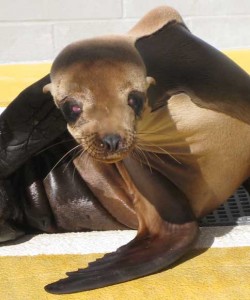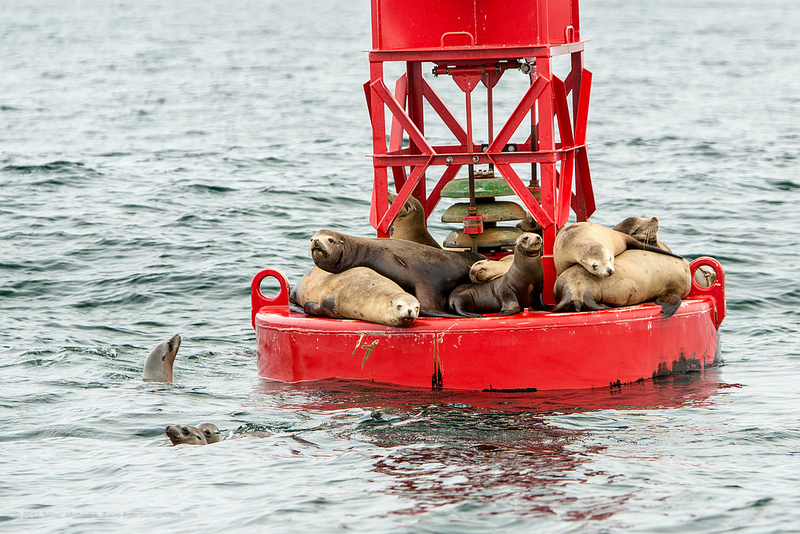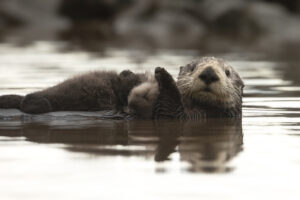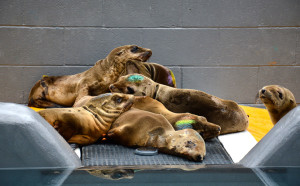Whirlybird has survived against all odds. In July, the male sea lion took a bullet to the head and landed on the shore of Corcoran Lagoon in Santa Cruz. Metal fragments had scattered throughout his head, destroying his eyesight.
Transferred to the care of the Marine Mammal Center in the Marin Headlands, Whirlybird now lives in surprisingly good spirits. But like many other marine mammal gunshot victims, his injuries are so severe that he’ll never be able to call the ocean home again.
Under the federal Marine Mammal Protection Act, it’s strictly illegal to harm, capture or kill a marine mammal. Nevertheless, gunshot victims like Whirlybird are a common occurrence along the coastlines of North America. Last month a bottlenose dolphin washed ashore in Louisiana after suffering from a gunshot behind its blowhole. Meanwhile, on the border of Oregon and Washington, 20 sea lions were found dead with gunshot wounds between April and June. Whirlybird’s case brought the Marine Mammal Center’s tally of gunshot victims up to six this year (it treated 539 gunshot victims between 1986 to 2010, which amounted to between 3 and 9 percent of overall admissions).

While the number of victims has held steady over the years, there’s been little progress in solving the marine mammal gunshot cases. That’s because the oceans are vast and go largely unpoliced, a kind of Wild West that produces no discernible witnesses or evidence. The ocean’s game warden, the Office of Law Enforcement at the National Oceanic and Atmospheric Administration (NOAA), usually has only the animal itself to examine.
“Bullet fragments aren’t enough. Though we may be able to identify the type of firearm used, we still don’t know who the weapon belongs to. We end up with a lot of open cases,” says Martina Sagapolu, the acting special agent of NOAA’s southwest division of law enforcement.
Officials often don’t even know where the crime occurred.
“Injured sea lions could have traveled quite a distance before stranding. The shot could’ve happened miles away at sea,” says Jim Oswald, a Marine Mammal Center spokesperson.
What’s even more troubling is that the extent of the problem is unknown, because presumably many shootings go undiscovered.
“We definitely don’t see all of the gunshot victims,” said Bill Van Bonn, the Marine Mammal Center’s staff veterinarian. “What we don’t see are the acute, fatal gunshots and the ones that are minor.”
So the number of gunshot victims is very likely an underestimate. In the last 24 years in California, the tally of recorded gunshot cases includes 988 pinnipeds, 12 cetaceans, and one leatherback sea turtle, according to NOAA reports.

A fight over fish?
While NOAA has found no hotspots or clear trends in the shootings, most cases seem to be happening in areas where schools of fish have moved closer to shore, possibly sparking battles as marine mammals interact with fishing operations, said Sagapolu.
Every summer the Marine Mammal Center sees a surge in gunshot victims, of which California sea lions are the overwhelming majority.
“There are more people out recreating and boating, which means more people are in contact with sea lions so the likelihood of conflict is higher,” said Van Bonn.
Getting into trouble
Juvenile males seem to be the ones most at risk, as their naïveté and curiosity get them into trouble fast. Young males have yet to learn to forage for fish farther off the coast and consequently are competing with the same fish that fishermen go after.
Unlike skittish harbor seals, California sea lions are also quick to habituate and are fond of human spaces, like docks and harbors. At Monterey Bay, sea lions are known to have capsized uncovered boats as they pile on for an evening shuteye.
Most marine mammals are shot in the head or spine as they skim the ocean’s surface. The prognosis of is far from uplifting. The Marine Mammal Center, which handles a 600-mile rescue range, reports that 21 percent of its gunshot admits survive, and are either released back into the wild or placed at zoos and aquariums.
Whirlybird may have beaten the odds, recovering well with his penmate Mr. Peppy. However, Whirlybird’s journey is not over. Each day he must prepare for his new life as a blind sea lion, undergoing extensive training by rehabilitation staff so that he can learn how to thrive at a future home at a zoo.
Courtney Quirin is a Bay Nature editorial intern.





